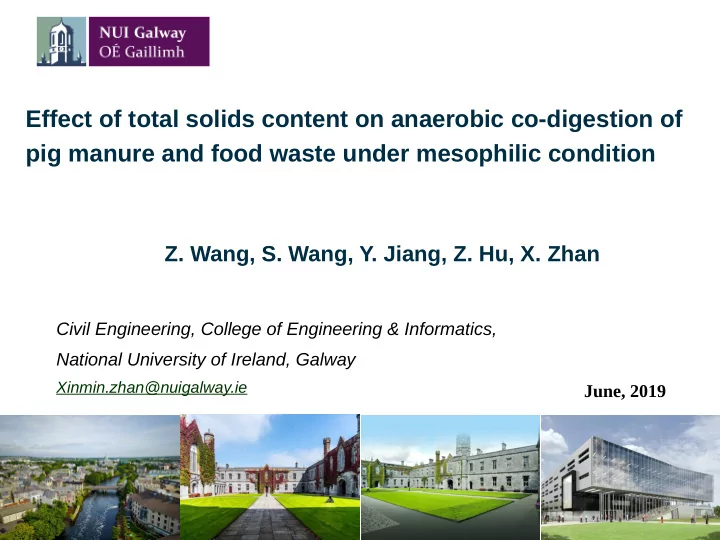

Effect of total solids content on anaerobic co-digestion of pig manure and food waste under mesophilic condition Z. Wang, S. Wang, Y. Jiang, Z. Hu, X. Zhan Civil Engineering, College of Engineering & Informatics, National University of Ireland, Galway Xinmin.zhan@nuigalway.ie June, 2019
Background Renewable and eco-friendly technology — Anaerobic digestion Agricultu ral Electri wastes Gas Municip city grid al bio- Anaero Feed Upgrade Biometha wastes Biog bic Energy ne as digeste crops r Industri al Digest wastes ate Heatin Vehicle and g Feedstocks fuel wastewa ter Fertili Agricultur zer e 2
Background Wet and dry anaerobic digestion Wet/Liquid AD (with TS < 10%) Conventional AD: usually operated with TS 2–6%* Deficiencies A d v a n t a g e s - High energy input requirement reducing digester size/volume. - High cost for digestate post-treatment decreasing energy consumption for heating. Increased TS avoiding high cost of liquid Dry AD(with TS ≥ 15%) digestate management. - An alternative to solve these problems. producing methane-rich biogas. - More attractive. low consumption of water. * Liu et al, 2016 3
Background Challenges for dry AD Reduced Inhibitory factors Impact moisture • Mass Intermediates transfer accumulation limitation • High VFA Suppressed Dry AD concentration microbial activity system Imbalance between • High acidogenesis and ammonia methanogenesis concentratio n • Long start-up time • Limited methane production rate • Low VS removal efficiency 4
Methods and material Experimental setup Total solids content: 5%, 10%, 15%, 20%. Substrates: Pig manure and food waste ( PM/FW ratio of 25:25 * by VS content ). Reactors: R 1 ~R 12 , 2 L Tap bottles (in triplicate at each TS content, 12 totally). Inoculum: Dewatered anaerobic sludge from a local municipal WWTP. Condition: Temperature 37.0 ℃ ; Shaken once by hand every day. Constant temperature incubator CH 4 、 CO 2 Thermometer Mixture 37.0 substrates ℃ Outlet Schematic diagram of anaerobic reactors *Jiang et al, 2018 5
Methods and material Characteristics of Substrates Physicochemical properties of PM and FW and seed sludge Solid fraction No. Characteristics Food waste Seed sludge of pig manure 1 pH 7.57±0.03 4.93±0.02 7.77±0.03 2 Moisture content (MC, %) 77.1±0.01 59.5±0.38 80.0±0.05 3 Total solids (TS, %) 22.90±0.01 40.52±0.38 20.02±0.05 4 Volatile solids (VS, %) 17.93±0.01 39.96±0.30 13.76±0.08 5 VS/TS (%) 78.4 96.2 68.7 6 SCOD (g/L) 40.9 126.8 7.1 7 TCOD (g/L) 197.6 271.4 190.1 Total volatile fatty acid 8 24 035.9 8794.0 0 (VFA, mg Acetate/L) Total ammonia nitrogen 9 4156.3 240.2 1793.3 (TAN, mg/L) Free ammonia nitrogen 10 85.76 0.01 57.94 calculated (FAN, mg/L) 6
Results and discussion Biomethane production • 20%-TS digesters obtained a relatively-low SMY • Prolonged lag phase with the increase of TS, especially with 20%-TS • Two peaks occurred during digestion 7
4 Results and discussion Optimum pH: 6.8~7.2 • A lower pH value around 7.5 occurred in R 4 -20% before day 25. • pH values were all within the acceptable range of 6.5-8.5. • More time was needed for R 4 -20% before reaching a constant TS 8
Results and discussion TAN concentration FA N • The release of ammonia proceeded rapidly at the beginning according to the steep increment tendency • At fjsrt several days, FAN increased distinctly due to the rapid release of ammonia. • The inhibition of free ammonia on methanogens occurred in TS- 15% and TS-20% digesters (FAN up to 400 mg-N/L) 9
Results and discussion VFA concentrations 10
Results and discussion Microbial community analysis At the phylum At genus level level • Phyla Firmicutes (43.9-49.1%), Proteobacteria (18.6-39.1%), Chloroflexi (3.3- 8.8%) and Planctomycetes (1.9-6.8%) dominated in dry digesters. 11
Results and discussion At genus level • No big change in wet AD, Methanothrix was dominant. • On day14, microbial community in dry AD is similar with wet AD, and shifting occurred in dry AD with the incubation time. • Methanosarcina was predominant in dry AD, followed by Methanosphaerula and Methanoculleus. 12
Results and discussion Methanogenic pathways Wet digestion Dry digestion • Hydrogenotrophic methanogenesis gradually increased along with the incubation time in dry AD. • The dominance of Methanosarcina , Methanosphaerula and Methanoculleus might be responsible for the enhanced resistance capacity in dry AD. 13
Conclusion 20%-TS digesters obtained a relatively-low SMY, and prolonged lag phase. Hydrogenotrophic methanogenesis gradually increased and was dominant in the dry AD process.
Thank you! Thank to Science Foundation Ireland for financially supporting our research 15
Recommend
More recommend